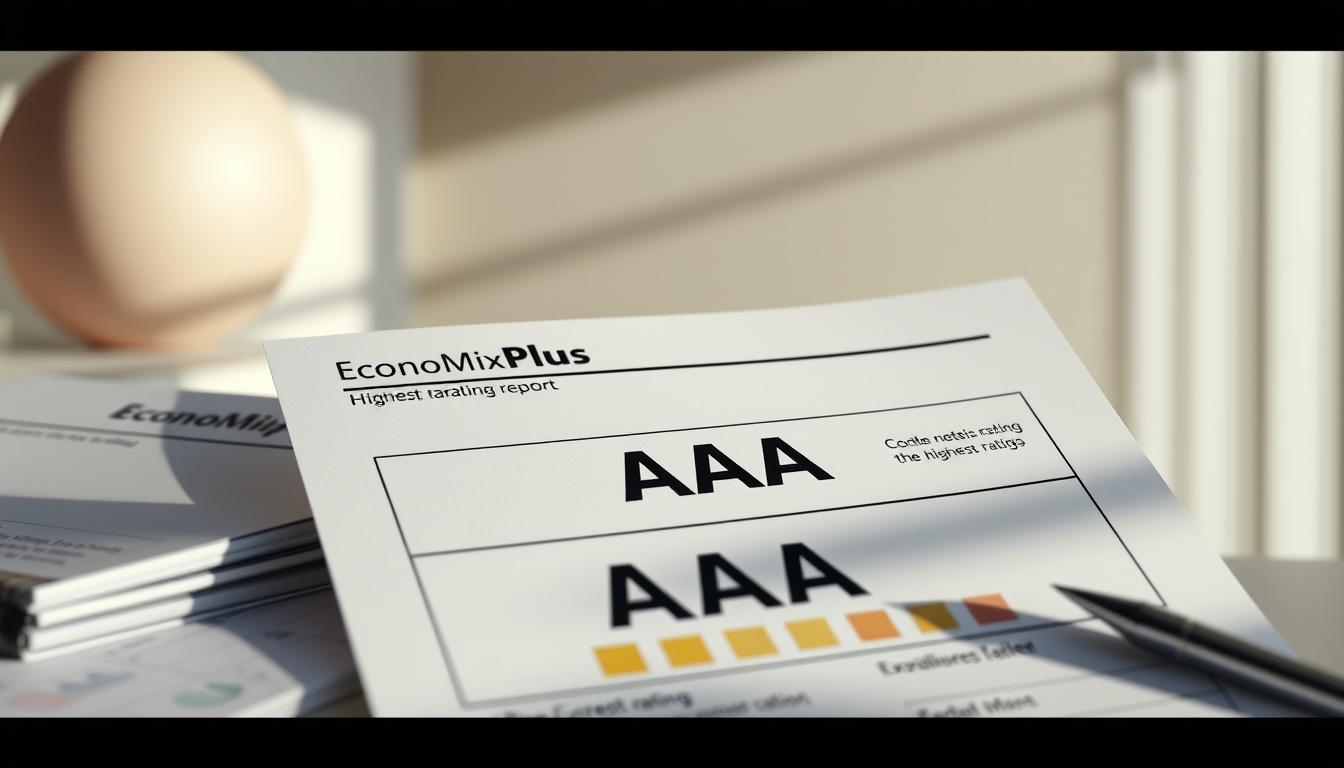Several countries around the globe boast exceptionally high credit ratings, a testament to their robust economies and financial stability. Credit rating agencies play a crucial role in assessing a country’s creditworthiness, and their evaluations can significantly impact international investor confidence.
Countries with top-tier credit ratings are typically those with strong economic fundamentals, stable political environments, and a history of fiscal responsibility. Nations such as Australia, Canada, and Switzerland are among those that have achieved the highest possible rating, AAA, from major credit rating agencies.
Key Takeaways
- An overview of countries with the highest credit ratings globally.
- Understanding how sovereign credit ratings are determined.
- The role of major credit rating agencies in assessing country risk.
- Economic and political factors contributing to top-tier credit ratings.
- The impact of high credit ratings on a country’s global economic standing.
Understanding Sovereign Credit Ratings
Sovereign credit ratings serve as a benchmark for assessing the creditworthiness of a nation. These ratings are crucial for investors and policymakers as they provide insights into a country’s ability to manage its debt and economic stability.
What Are Sovereign Credit Ratings?
Sovereign credit ratings are assessments of a national government’s ability and willingness to repay its debts according to the agreed terms. They serve as indicators of a country’s economic stability, fiscal responsibility, and overall financial health. A high credit rating indicates a lower risk for investors, suggesting that the country is likely to meet its financial obligations.
The difference between investment grade and speculative grade ratings is significant. Investment grade ratings, such as BBB− or higher from Fitch, indicate a stable economic environment, while speculative grade ratings suggest a higher risk of default.
The Three Major Credit Rating Agencies
The three major credit rating agencies are Standard & Poor’s (S&P), Moody’s, and Fitch Ratings. These agencies play a significant role in the global financial system by evaluating countries based on both quantitative economic data and qualitative assessments of political stability. For instance, S&P Global Ratings provides critical assessments that influence international perceptions of a country’s economic management.
Each agency has its rating scale and methodology, with some similarities and differences in their approaches. Understanding these differences is crucial for a comprehensive view of a country’s credit rating.
How Credit Ratings Are Determined
Credit rating agencies employ a multifaceted approach to assess a country’s creditworthiness. This comprehensive methodology involves evaluating various economic and political factors that influence a nation’s ability to meet its financial obligations.
Economic Factors
Economic indicators play a crucial role in determining credit ratings. Agencies examine factors such as GDP growth, inflation rates, and fiscal balance to gauge a country’s economic health. A strong economy with stable growth and low inflation is likely to receive a higher credit rating.
Political Stability
Political stability is another key factor in determining credit ratings. Agencies such as S&P Global and Fitch Ratings assess the effectiveness of governance, policy predictability, and institutional strength. Countries with stable governments and robust institutions are considered less risky and are more likely to have higher ratings, which can positively influence their bonds and overall global ratings.
Debt Management
Agencies also evaluate a country’s debt management practices, including debt-to-GDP ratios, debt structure, and debt servicing capacity. Effective debt management is critical to maintaining a good credit rating. As noted by a Fitch Ratings report, “A country’s ability to manage its debt is a key factor in its creditworthiness.”
External factors such as geopolitical risks and global economic conditions can also impact a country’s rating. Transparency in government finances and policy-making contributes to stronger sovereign credit ratings. By considering these factors, rating agencies provide a comprehensive assessment of a country’s creditworthiness, reflected in its credit rating.
The Significance of AAA Ratings
The significance of AAA ratings cannot be overstated, as they represent the pinnacle of creditworthiness in the global economy. A AAA rating is the highest credit assessment a country can receive, indicating exceptional financial stability, strong economic fundamentals, and prudent fiscal management.
Understanding the distinction between investment grade and speculative grade ratings is crucial for comprehending the implications of a AAA rating. Investment grade ratings signify a low risk of default, while speculative grade ratings indicate a higher risk.
Investment Grade vs. Speculative Grade
Investment grade ratings are assigned to countries that demonstrate a strong ability to meet their financial commitments. These countries are considered to have a low credit risk. On the other hand, speculative grade ratings are given to countries with a higher risk of default. The difference between these two categories is significant, as it directly affects a country’s ability to attract investors and secure loans at favorable interest rates.
Key differences between investment and speculative grade ratings include:
- Credit risk: Investment grade indicates low risk, while speculative grade suggests higher risk.
- Investor confidence: Countries with investment grade ratings tend to attract more investors.
- Borrowing costs: Investment grade countries typically enjoy lower borrowing costs.
Benefits of High Credit Ratings
Countries with AAA ratings enjoy numerous benefits, including lower borrowing costs, increased investor confidence, and enhanced economic stability. A high credit rating can also contribute to currency stability and overall economic resilience during times of global financial turbulence.
The table below summarizes the key benefits of high credit ratings:
| Benefits | Description |
|---|---|
| Lower Borrowing Costs | Countries with high credit ratings can secure loans at more favorable interest rates. |
| Increased Investor Confidence | High credit ratings attract more investors, both domestic and foreign. |
| Enhanced Economic Stability | A high credit rating contributes to overall economic stability and resilience. |
Maintaining a AAA rating requires ongoing fiscal discipline and economic management. Countries must continue to demonstrate strong economic fundamentals and prudent fiscal policies to retain their top credit rating.

Which Countries Have the Highest Credit Ratings in the World?
The world’s top economies are distinguished by their high credit ratings, reflecting their financial stability and reliability. These countries have demonstrated strong economic fundamentals, prudent fiscal policies, and robust governance structures.
Elite Nations with Triple-A Ratings from All Agencies
A handful of countries have achieved the highest possible credit rating, AAA, from all three major credit rating agencies: Fitch Ratings, Moody’s, and Standard & Poor’s. These nations include Australia, Canada, Denmark, Germany, Luxembourg, Netherlands, Norway, Singapore, Sweden, and Switzerland.

These countries share certain characteristics that contribute to their high credit ratings. They have strong economies, low debt levels, and stable political systems. Their fiscal policies are prudent, and they have a history of honoring their financial obligations.
| Country | Fitch Ratings | Moody’s | Standard & Poor’s |
|---|---|---|---|
| Australia | AAA | Aaa | AAA |
| Canada | AAA | Aaa | AAA |
| Germany | AAA | Aaa | AAA |
| Singapore | AAA | Aaa | AAA |
| Sweden | AAA | Aaa | AAA |
| Switzerland | AAA | Aaa | AAA |
Nations with Triple-A Ratings from At Least One Agency
In addition to the countries with AAA ratings from all three agencies, several other nations have achieved this rating from at least one major credit rating agency. For instance, the United States has a AAA rating from Moody’s, while New Zealand shares this rating. The European Union has a AAA rating from Fitch and Moody’s but is rated AA by Standard & Poor’s.
The differences in ratings among the agencies can be attributed to their distinct assessment methodologies and criteria. Understanding these variations is crucial for investors and policymakers to make informed decisions.
Top-Rated Countries: Standard & Poor’s Perspective
Standard & Poor’s sovereign credit ratings offer a benchmark for evaluating the financial stability of countries. As one of the major credit rating agencies, S&P’s assessments play a significant role in determining the creditworthiness of nations.
S&P’s AAA-Rated Nations
S&P awards its highest rating, AAA, to countries with exceptionally strong economic fundamentals and low debt levels. Currently, countries with a AAA rating from S&P include Australia, Canada, Denmark, Germany, Liechtenstein, Luxembourg, Netherlands, Norway, Singapore, Sweden, and Switzerland. These nations share common characteristics such as robust economic growth, prudent fiscal policies, and stable political environments.

S&P’s AA+ Rated Nations
Countries rated AA+ by S&P, such as Austria, Finland, New Zealand, United States, Hong Kong, and Taiwan, are considered to have very strong credit profiles, albeit with slightly higher risks compared to AAA-rated nations. The United States, for instance, was downgraded from AAA to AA+ in 2011 due to concerns over its rising debt levels and political gridlock. Understanding the differences between AAA and AA+ ratings can provide insights into S&P’s evaluation criteria.
| Country | S&P Rating | Economic Indicator |
|---|---|---|
| Australia | AAA | Strong GDP Growth |
| United States | AA+ | Large Economy, High Debt |
| Singapore | AAA | Business-Friendly Environment |
The table above illustrates the difference in S&P ratings between countries like Australia and Singapore, which are rated AAA, and the United States, which is rated AA+. The economic indicators highlight the factors that contribute to these ratings, such as GDP growth and debt levels.
Top-Rated Countries: Fitch Ratings Perspective
Fitch Ratings provides a unique perspective on sovereign creditworthiness, offering insights into the world’s most creditworthy nations. Their rigorous methodology and insightful analysis make them a key player in the credit rating industry.
Fitch’s AAA-Rated Nations
Fitch Ratings has assigned its highest AAA rating to several countries, reflecting their strong economic fundamentals and stable political environments. These nations include Australia, Austria, Denmark, Germany, Luxembourg, Netherlands, Norway, Singapore, Sweden, and Switzerland.
The economic and political factors that contribute to a AAA rating include a strong fiscal policy, low debt levels, and a stable political system. These countries have demonstrated their ability to manage their economies effectively, even in times of global economic uncertainty.
- Strong Fiscal Policy: Countries with a AAA rating have shown a commitment to prudent fiscal management.
- Low Debt Levels: These nations have maintained debt levels that are considered sustainable.
- Stable Political System: Political stability is a key factor, as it contributes to a favorable business environment.
Fitch’s AA+ Rated Nations
In addition to AAA-rated countries, Fitch also assigns a AA+ rating to nations that have a very strong credit profile but may have some minor concerns. Countries with this rating include Canada, Finland, the United States, and New Zealand.
The United States, for instance, was recently downgraded from AAA to AA+ in August 2023 due to concerns about its fiscal management and political governance. This decision highlights the evolving nature of sovereign credit ratings and the factors that can influence them.
Fitch’s methodology for sovereign ratings involves a comprehensive analysis of economic and political factors. While similar to other rating agencies, Fitch’s approach has unique aspects that set it apart.
Top-Rated Countries: Moody’s Perspective
Moody’s sovereign ratings are a crucial indicator of a country’s financial health and stability. As one of the three major credit rating agencies, Moody’s provides investors and policymakers with essential insights into the creditworthiness of various nations.
The agency’s rating methodology is multifaceted, taking into account factors such as economic resilience, institutional strength, and the ability to honor debt obligations. This comprehensive approach allows for a nuanced assessment of a country’s financial standing on the global stage.
Aaa-Rated Nations
Countries that achieve Moody’s highest Aaa rating are considered to be among the most creditworthy in the world. Currently, this elite group includes Australia, Canada, Denmark, the European Union, Germany, Luxembourg, Netherlands, Norway, Singapore, Sweden, Switzerland, the United States, and New Zealand. These nations share certain characteristics that contribute to their financial stability, such as robust economic fundamentals, strong institutional frameworks, and a history of prudent debt management.
- Strong economic growth and stability
- High institutional quality and governance
- Low debt levels relative to GDP
Aa1 Rated Nations
Moody’s Aa1 rating is the second-highest tier, indicating a very high level of creditworthiness. Countries in this category, including Austria, Finland, and South Korea, demonstrate strong economic fundamentals and a commitment to fiscal responsibility. While they may not have achieved the Aaa rating, they are still considered to have a very low risk of default.
The distinction between Aaa and Aa1 ratings often comes down to subtle differences in economic indicators and institutional factors. For instance, Aa1-rated countries might have slightly higher debt levels or be more vulnerable to external economic shocks compared to their Aaa-rated counterparts.
Notably, the United States maintains its Aaa rating from Moody’s, despite experiencing downgrades from other rating agencies. This assessment underscores Moody’s confidence in the U.S. economy’s underlying strength and its ability to manage its debt obligations.
Regional Analysis of Credit Ratings
Different regions exhibit distinct credit rating patterns influenced by local factors. A closer look at these regional trends provides valuable insights into the global economy.
Europe’s Credit Rating Landscape
Northern European countries generally maintain high credit ratings, while some Southern European nations faced downgrades during the Eurozone crisis. European Union membership has a stabilizing effect on credit ratings, as it promotes economic integration and fiscal discipline among member states.
Asia-Pacific Credit Ratings
The Asia-Pacific region is home to economic powerhouses like Singapore, Australia, and New Zealand, which enjoy top credit ratings. Countries like China, Japan, and South Korea have varying creditworthiness due to factors such as debt levels and economic diversification.
North America’s Credit Standing
North America, particularly the United States and Canada, has a mixed credit rating landscape. The U.S. has experienced rating downgrades in the past, while Canada maintains a high credit rating. Regional economic challenges, including debt levels and political stability, impact sovereign credit ratings.
Emerging trends in regional credit ratings suggest shifts in global economic power. Understanding these trends is crucial for investors and policymakers alike.
The Impact of Credit Ratings on National Economies
A country’s credit rating is a critical factor that affects its economic prospects, influencing everything from borrowing costs to investor confidence. Sovereign credit ratings, assigned by major credit rating agencies like Fitch Ratings and S&P Global, play a significant role in determining a nation’s economic health.
Influence on Borrowing Costs and International Investment
Credit ratings directly impact a government’s borrowing costs. A high credit rating can lead to lower borrowing costs, as it signifies a lower risk of default. This, in turn, can facilitate the financing of public services and infrastructure projects. On the other hand, a low credit rating can increase borrowing costs, making it more challenging for a government to finance its activities. According to a report by the Bank for International Settlements, credit ratings have a significant impact on the cost of borrowing for governments https://www.bis.org/publ/work648.pdf.
High credit ratings can also attract international investment by signaling economic stability and reduced risk. Investors are more likely to invest in countries with high credit ratings, as they are perceived to be more stable and less likely to default on their debt obligations.
Impact on Currency Stability and Economic Growth
Credit ratings can also influence currency stability. A downgrade in a country’s credit rating can lead to currency depreciation, as investors become more risk-averse and less likely to hold the country’s currency. Conversely, an upgrade can lead to currency appreciation, as the country’s economic prospects improve.
The impact of credit ratings on economic growth is multifaceted. High credit ratings can lead to increased investor confidence, which can stimulate economic growth through increased investment and business expansion. On the other hand, low credit ratings can lead to decreased investor confidence, potentially slowing down economic growth.
In conclusion, credit ratings have a significant impact on national economies, influencing borrowing costs, international investment, currency stability, and economic growth. Understanding the dynamics of credit ratings is crucial for policymakers and investors alike.
Conclusion
The elite group of countries with AAA/Aaa ratings from all three major agencies is a testament to their financial stability. These nations have demonstrated exceptional economic management and fiscal responsibility, setting them apart in the global economy. Sovereign credit ratings serve as important indicators of a country’s economic health and overall financial stability.
The landscape of top-rated countries has evolved over time, with fewer nations maintaining perfect ratings than before the 2008 financial crisis. Monitoring credit ratings is crucial as they signal changing economic conditions and government fiscal management. Even economically powerful nations like the United States can face downgrades when agencies perceive increased fiscal or political risks.
While ratings are important indicators, they represent just one perspective on a country’s economic strength. As the global economy becomes increasingly complex and interconnected, the importance of understanding sovereign credit ratings will continue to grow. The future outlook for global sovereign ratings will be shaped by factors such as economic trends, government policies, and global events.
FAQ
▶
▶
▶
▶
▶
▶
▶














